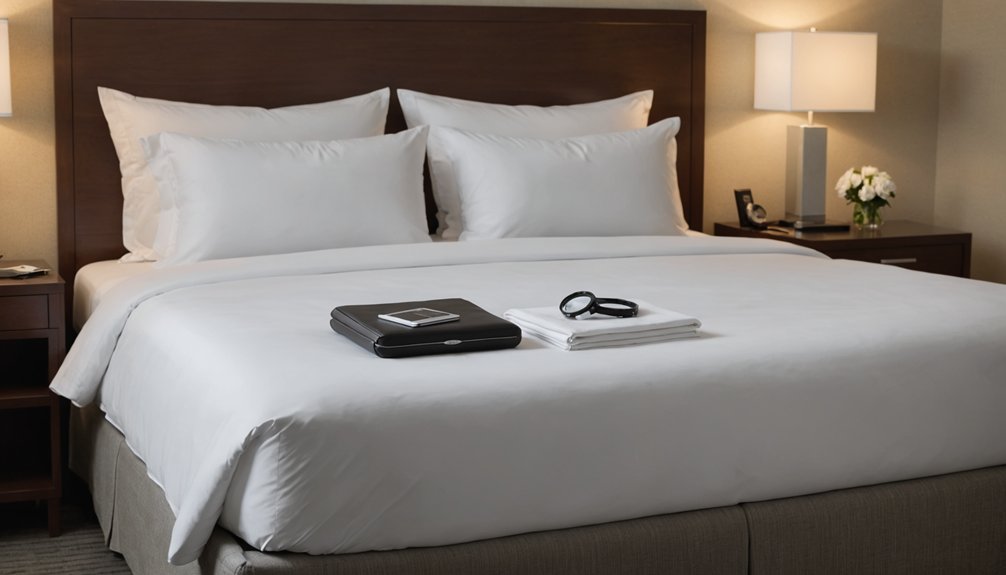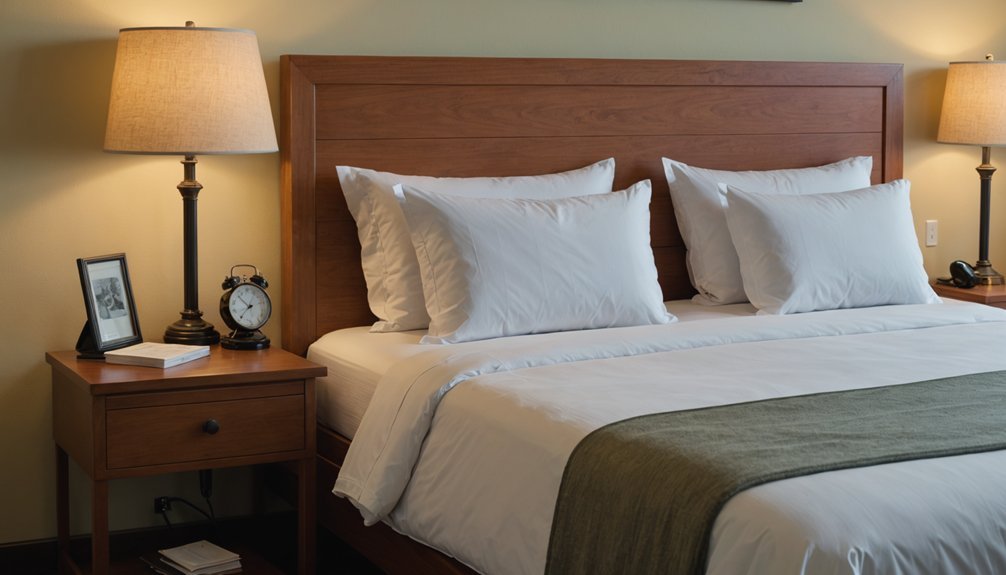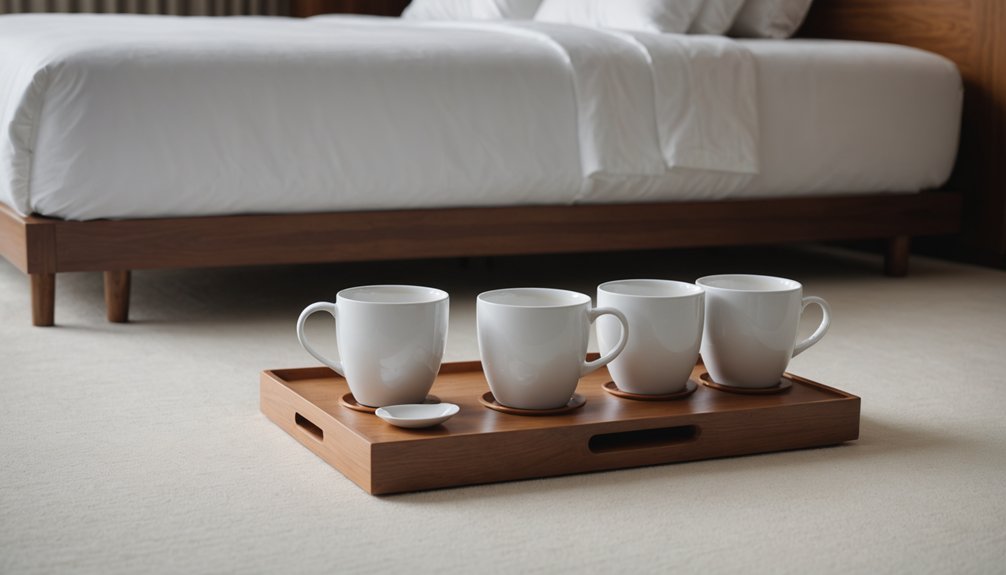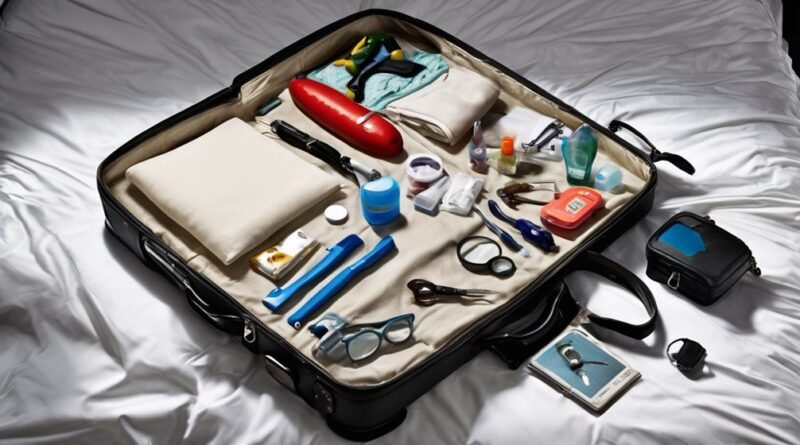Bed Bug Prevention Guide: Travel, Hotels & Home Protection
Protect yourself by knowing bed bugs hitchhike on luggage, clothing, and furniture, then crawl through buildings. Spot early signs: rusty blood spots, black dots, shed skins, tiny eggs, and a sweet musty odor. In hotels, inspect beds, headboards, furniture, and baseboards; keep bags on racks or in the bathroom. Treat luggage, bag dirty clothes, and heat-dry laundry on return. At home, use interceptors, encase mattresses, and keep beds off walls. Call pros for spreading infestations. Next, you’ll see exactly how to do it all.
Key Takeaways
- Inspect hotel beds, headboards, furniture, and room edges for blood spots, black dots, shed skins, eggs, and musty odor before settling in.
- Keep luggage off beds; use racks or bathroom, apply luggage-safe repellent, encase soft bags, and bag dirty clothes until laundering.
- At home, isolate beds: remove bed skirts, keep bedding off floors, and maintain a two-foot gap from walls with clear 36-inch pathways.
- Install interceptor cups under bed and furniture legs, use encasements on mattresses/box springs, and rotate supplemental monitors; log findings weekly.
- Call professionals for multi-room activity or failed DIY; prefer heat treatments and follow integrated pest management for lasting control.
Understanding How Bed Bugs Spread

Although bed bugs can’t fly, they spread efficiently through two pathways: they hitchhike long distances on people’s belongings (passive dispersal) and they crawl short distances within buildings (active dispersal).
Bed bugs spread by hitchhiking on belongings and crawling within buildings, despite being unable to fly.
You move them between locations when they ride in luggage, backpacks, purses, briefcases, jackets, and furniture. Simply visiting an infested home or staying where turnover is high can transfer them. They thrive on human mobility.
Inside buildings, they crawl from dark resting places to reach you and expand to adjacent rooms. In community settings, they often move room-to-room through ventilation ducts. Physical barriers and building design can slow or channel this spread.
While crawling covers only short distances, it’s the primary way infestations grow within a building.
Models show rapid community spread: after a single introduction, most houses can become infested within months. Infectious transmission between occupied units drives the majority of spread. Disclosure policies that require landlords to notify tenants of past infestations can reduce spread by discouraging moves into known infested units, creating a partial quarantine effect.
Overcrowding, lower income, group living, and high tenant turnover intensify risk.
Early Detection: What to Look For
How can you spot bed bugs before they spread? Start with physical evidence on bedding. Look for rusty blood spots, black ink-like dots (excrement), and shed skins around mattress seams and box spring corners.
Tiny, pale eggs or eggshells hide in tight crevices; they’re white, about the size of two grains of salt. During inspections, you may see live bugs: adults are apple-seed sized and reddish-brown; nymphs are pinhead-small, white or tan before feeding. They do not transmit diseases, but their bites can cause itching and allergic reactions.
Check strategic areas weekly: mattress seams and tags, box spring corners, bed frame crevices, behind headboards and pictures, along wallpaper seams, carpet edges, and under seat cushions.
A sweet, musty odor can signal an established infestation.
Don’t rely only on bites. Reactions vary: some people show no marks, others develop itchy clusters or lines on exposed skin, sometimes appearing up to 14 days later.
Use bed bug monitoring devices to catch early activity, especially during peak summer travel.
Hotel Room Inspection Checklist

You’ve learned the early signs; now put them to work the moment you enter a hotel room. Before unpacking, grab a flashlight or phone light, magnifying glass, camera, and small jars. Ask for management’s inspection/reporting form to document anything suspicious. Remember that bed bugs can be found in any accommodation type, so inspect all rooms regardless of appearance. Pay close attention to seams and crevices in furniture, as these are common hiding spots for bed bugs. Don’t forget to also inspect the mattress and box spring thoroughly. It’s crucial to inspect hotel room for bed bugs before settling in, as early detection can save you from a much larger problem.
Start with the bed: remove pillows and pull back all sheets. Inspect mattress seams, edges, and tags; look for live bugs, eggs, blood spots, or dark pen-like stains. Check between the mattress and box spring, then examine the top, bottom, and all seams of both components.
Move to the frame and headboard: shine light into crevices, corners, joints, and screw holes. Slide a card along the headboard edge and look behind it.
Scan furniture: seams and folds of chairs/couches, under cushions, inside nightstands and dressers (joints/undersides), luggage rack straps, and armoires.
Finish the perimeter: drapery folds, behind wall art, along baseboards/outlets/trim, and carpet near beds. Repeat for every bed.
| Step | What to check |
|---|---|
| Bed | Sheets, seams, tags, box spring |
| Frame | Headboard edges, joints, screw holes |
| Room | Furniture, racks, drapes, baseboards |
Safe Luggage Handling While Traveling
Even before you unzip your suitcase, plan how you’ll handle it to keep hitchhikers out of your home. Treat luggage in a well‑ventilated area before trips: lightly apply a luggage-safe repellent to seams and let it dry. Use a snug encasement on soft bags, and pack dirty clothes in sealed bags.
On arrival, place luggage on a inspected rack pulled away from walls, or store it in the bathroom if the rack looks questionable. Keep bags off beds and carpets. Bed bugs are excellent hitchhikers, so staying vigilant with these steps helps prevent bringing them home.
Use a flashlight to inspect seams, folds, zippers, handles, wheels, and pockets. Look for live bugs, eggs, brown or red spots, or a sweet, musty odor. Before departing, repeat the check and examine the area where your luggage sat.
At home, unpack in a garage, mud room, or laundry room—never the bedroom. Immediately run clothing in the dryer on medium or high heat for 30 minutes.
Vacuum the suitcase with brush and crevice tools. If you find bugs, seal items in plastic bags.
Using Interceptor Cups for Detection and Protection

Two simple devices under each bed or sofa leg can expose hidden bed bugs and block their path. Place interceptor cups beneath every leg and pull furniture a few inches from walls and curtains so bugs can’t bypass the traps.
Interceptors exploit two behaviors: bed bugs actively seek a host and readily climb coarse surfaces. They crawl into the outer well during normal dispersal, then can’t escape the smooth plastic. Passive monitors are valuable because early detection helps avoid more costly control measures.
Interceptors exploit bed bugs’ urge to hunt and climb, trapping them on smooth plastic they can’t escape.
Use dual-bowl models. Bugs trying to climb up from the floor fall into the outer ring; those coming down from furniture drop into the inner cup, where insecticide dust can kill them on contact.
Check weekly. Interceptors often reveal low-level infestations missed by visual searches. They outperform inspections, capturing nearly six times more bed bugs. Studies report averages of 207 in large bowls and 13 in small ones, with about 8.8 per apartment in seven days.
Maintain, clean, and reposition as needed for ongoing detection and protection.
Heat and Cold Treatments That Work
Interceptors can flag activity, but heat and cold actually knock infestations down. When you need results fast, professional heat treatments deliver about 95% success in a single visit, often outperforming chemicals that require repeats.
- Temperature and time: Expose bed bugs to at least 118°F (48°C) for 90 minutes to achieve lethal effect; 122°F (50°C) kills all stages in about 20 minutes. Eggs are the toughest—precision matters.
- How pros do it: Technicians use heaters, high‑velocity fans, and thermal imaging to raise and hold whole‑room temperatures and eliminate cold spots. Heat penetrates mattresses, furniture joints, baseboards, and clutter.
- Coverage: Proper circulation drives lethal heat into cracks and textiles where sprays can’t reach, reducing retreatments and residue concerns.
- Cold options: You can freeze small items; maintain subzero temperatures for days to guarantee the core reaches lethal cold. Always bag and seal before freezing, then thaw sealed.
- Success factors: Even heat, sustained exposure, reduced clutter, and diligent prep determine outcomes.
Monitoring Tools: Sticky Cards and Electronic Devices
You’ll place sticky cards along bed legs, baseboards, and near sleeping areas, but don’t rely on them alone since pitfall-style interceptors and CO2/heat monitors detect far more bed bugs.
Use electronic monitors strategically for short, targeted checks—run CO2 or heat-based devices overnight near beds and sofas where hosts rest.
Rotate placements weekly and log captures to confirm presence, gauge activity, and decide when escalation’s needed.
Sticky Card Placement
Start by treating sticky cards as supplemental monitors you place where bed bugs travel, not as your primary detection tool.
Choose smooth plastic-backed designs; rough, cardboard-like surrounds let bed bugs gain traction and escape, especially males and first-instar nymphs. Lower surface roughness boosts captures, and once bed bugs hit strong adhesive bordered by smooth material, they can’t regain grip.
Place cards in tight, hidden paths: behind headboards, mirrors, and picture frames; along bed legs, wall seams, and baseboards; and on routes between harborages and sleeping areas. Use multiple cards per room to raise odds, and leave them about a week before reviewing.
Expect modest sensitivity. Sticky cards passively record crawling activity and often miss low-level infestations.
Pair them with visual inspections and under-leg interceptors to raise detection rates.
Electronic Monitor Use
Two kinds of electronic monitors—active CO2/heat/lure devices and passive under-leg interceptors with add‑on sensors—can dramatically boost detection between visual checks.
Prioritize CO2-based attraction: bed bugs key on CO2, and dry ice traps often outperform CDC3000 and NightWatch, especially in occupied rooms. Active devices can run multiple nights; NightWatch matches passive traps when you deploy it for four nights, but it may underperform in large spaces if attractant concentrations drop.
Use passive interceptors under bed and sofa legs; they’ve matched dry ice traps when run seven days and outperform visual inspections for small infestations.
Add sensor modules for remote alerts. Place monitors near likely routes: behind headboards to catch freshly fed bugs, and by doors to capture mostly unfed wanderers.
Check nightly and log counts for trend tracking.
Home Setup to Prevent Bed Bug Movement
Even before treatments begin, set up your home to block and track bed bug movement so they can’t reach you and are easier to remove.
Pull beds and furniture at least two feet from walls. Remove bed skirts and keep bedding off the floor. Create 36-inch pathways around beds and major furniture so you can inspect and clean thoroughly. Maintain clear separation between clean zones and areas you suspect are infested.
Pull beds two feet from walls, remove bed skirts, and keep bedding off floors. Create clear 36-inch inspection paths.
Place interceptor devices under every bed and furniture leg. Use commercial models or DIY versions: two nested plastic containers, masking tape on the outside for climbing, and talcum powder or a thin oil layer inside to trap bugs.
Check weekly, clean debris, reapply powder, and replace any cracked units.
Encase all mattresses and box springs in smooth, strong, tightly zippered covers labeled for bed bugs or dust mites. Repair rips with duct tape or replace encasements.
Declutter, vacuum crevices, steam furniture, launder hot, and discard vacuum bags promptly.
When to Call a Professional and What to Expect
Although many infestations can be contained with diligent home measures, certain situations demand professional help to prevent spread and secure full eradication. Call a pro when:
- Bed bugs spread to multiple rooms or areas
- DIY attempts fail to eliminate the infestation
- Persistent activity continues despite repeated efforts
- High-risk situations involve health conditions or sensitive individuals
- Severe infestations show extensive hiding spots and contamination
Expect a professional process:
- Thorough inspection to define extent and severity
- Preparation: declutter, launder, and heat-treat textiles
- Targeted insecticide applications to cracks and hiding sites
- Follow-up inspections to confirm elimination
- Preventative tools such as encasements and interceptors
Choose the right provider:
- Research multiple companies and seek trusted recommendations
- Verify licenses and certifications
- Confirm specific bed bug expertise
- Review testimonials on effectiveness
- Confirm specialized equipment and methods
Watch for success indicators:
- Reduced activity and sightings
- No new bites
- No live bugs, feces, shed skins, or eggs
- Diminished signs in seams and furniture
- Clear monitoring over weeks without recurrence
Policies and Building-Wide Strategies to Stop Spread
When bed bugs threaten a shared building, you need clear policies and building-wide strategies that prevent spread before infestations take hold. Start with a baseline assessment: map current problems, likely risk points, and resources. Tailor your plan to the property type—rental housing, special needs residences, condos, or public spaces—and use multiple components, not one-off fixes.
Implement an IPM program; when done right, you can reach about 96% elimination in roughly 2.5 months.
Create reporting and response protocols. Require reports within five days (as in Chicago), designate the recipient, use standardized forms, and prioritize confirmation to set scope and action. Move fast to contain costs and spread.
Make physical changes: reduce clutter, seal baseboards, outlets, and trim near beds, choose molded-plastic furniture, swap carpets for hard floors, and position beds away from windows and storage.
Invest in monitoring and equipment, schedule biweekly follow-ups, and educate residents. Prohibit foggers and offer immediate assistance.
Frequently Asked Questions
Can Bed Bugs Live in Electronics or Small Appliances?
Yes, they can live in electronics and small appliances, but they’re not primary nesting sites.
You’ll see them use warm, nearby devices as temporary harborage during moderate to severe infestations. They squeeze into vents, ports, and seams, or arrive via cords and second‑hand gear.
Watch for dark spotting, shed skins, or a musty odor near power ports. Inspect and wipe devices, avoid using electronics in bed, and check used items before bringing them home.
Do Bed Bugs Transmit Diseases to Humans or Pets?
No—they don’t. You won’t get diseases from bed bugs, and neither will your pets.
Research shows they feed on humans, cats, and dogs but aren’t proven vectors. Labs have detected pathogens like T. cruzi and hepatitis B in bugs after feeding, yet transmission to hosts hasn’t been demonstrated.
You may still experience itchy welts, allergic reactions, or secondary skin infections from scratching. Compared with fleas and ticks, bed bugs are nuisance pests, not disease spreaders.
Are Essential Oils or DIY Sprays Effective Long-Term Solutions?
No, essential oils or DIY sprays aren’t reliable long-term solutions.
You might see short-term knockdown or repellency—compounds like thymol, carvacrol, geraniol, and eugenol can help—but residues degrade quickly, bed bugs cross barriers for heat and blood, and some aged residues even attract them.
Only a few vetted formulations (e.g., EcoRaider) show measurable, temporary effects and require frequent reapplication.
For sustained control, combine inspections, encasements, heat/steam, traps, and professional treatments.
How Long Can Bed Bugs Survive Without a Host?
They can survive months without a host. You should expect nymphs to last 2–3 months, with first instars dying much sooner.
Adults average about 4.5 months and, in ideal lab conditions, mature adults can stretch to roughly 400 days.
Cooler temperatures slow metabolism and extend survival; warmth and low humidity shorten it.
They can enter diapause, migrate for food, and occasionally feed on pets or rodents, so empty homes don’t guarantee eradication.
Can Secondhand Furniture Be Made Safe Without Professional Treatment?
Yes, but only with strict precautions.
Skip upholstered items.
Inspect every surface: seams, cracks, screw holes, and undersides with a flashlight and magnifier.
Use a thin card to probe tight gaps and run gloved hands along fabrics.
Treat with slow steam passes, wash removable fabrics, and dry on the hottest setting.
Solarize in clear plastic under direct sun when possible.
Quarantine in a garage for several days, re-inspect, vacuum, and discard debris outside.
Conclusion
You’ve got the know-how to stay ahead of bed bugs. Spot early signs, inspect hotel rooms, and keep luggage off beds. Use interceptor cups and monitors to catch hitchhikers fast. At home, seal gaps, reduce clutter, and isolate beds so bugs can’t move easily. If activity persists, call a licensed pro and follow prep instructions closely. Share prevention steps with neighbors and managers. With consistent habits and smart tools, you’ll cut risks and keep infestations from spreading.

